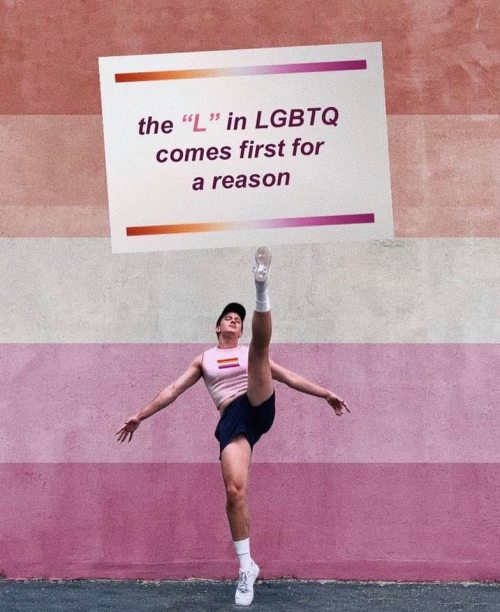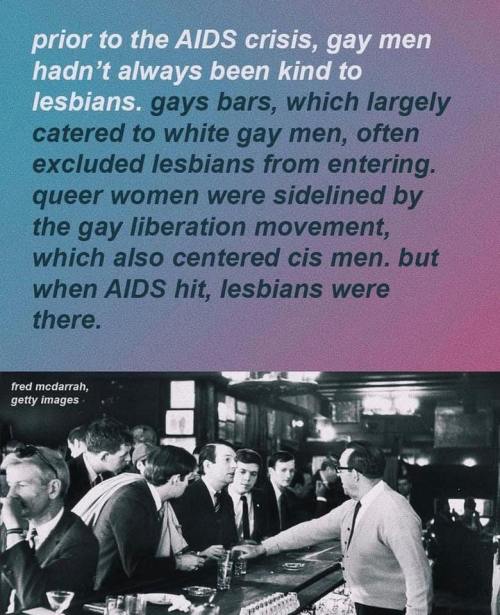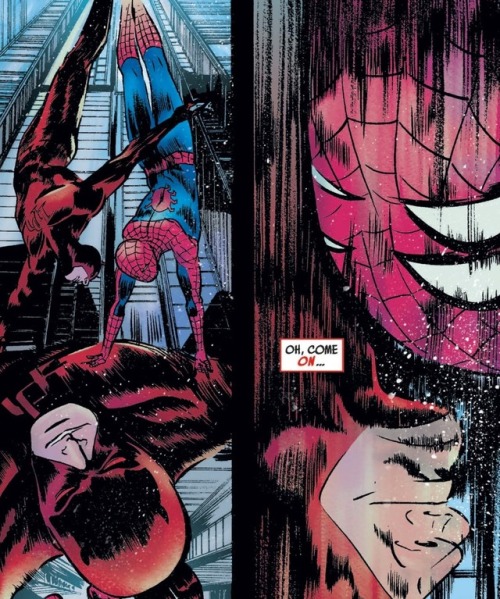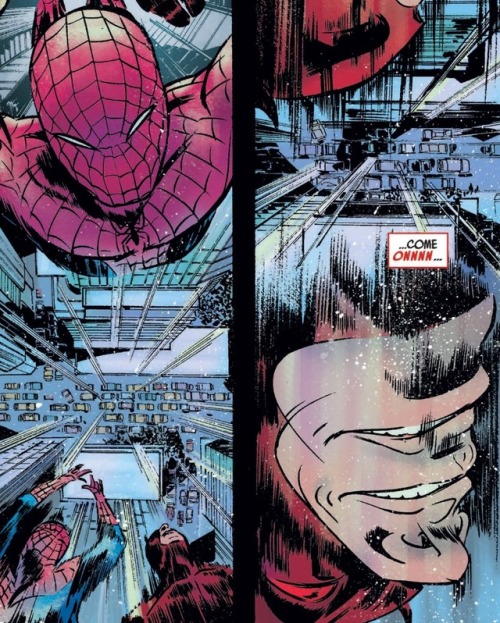Has Peter Parker Ever Had A Mullet I Feel It Deep In Bones He Had That Phase And I Must Know If It's
has peter parker ever had a mullet i feel it deep in bones he had that phase and i must know if it's canon
He's gotten close, I mean almost every hero had a mullet in the 90s. Whatever the fuck was happening with his hair in the ultimate universe is close. I'll let you decide what counts as a mullet. Although Ben and Kaine have canonically rocked pretty sick mullets, but so has Eddie Brock so maybe that's just a "dark mirror of Spider-Man" thing
You should talk to @earth90214 she's also on the mullet!Peter Parker brain wave and her art is gorgeous!!
More Posts from Mjapologist and Others




If it weren’t for experiencing life with you, and through you, there would be no reason to do what I do. If you believe that I am making this world a better place, then you must know that you are the one I am trying to make it better for.
Spider-Man Unlimited Vol 3 2: "Tests"



I miss it when peters apartment looked like a hot mess










The LGBTQ community has seen controversy regarding acceptance of different groups (bisexual and transgender individuals have sometimes been marginalized by the larger community), but the term LGBT has been a positive symbol of inclusion and reflects the embrace of different identities and that we’re stronger together and need each other. While there are differences, we all face many of the same challenges from broader society.
In the 1960′s, in wider society the meaning of the word gay transitioned from ‘happy’ or ‘carefree’ to predominantly mean ‘homosexual’ and was an umbrella term that meant anyone who wasn’t cisgender or heterosexual. The community embraced the word ‘gay’ as a mark of pride.
The modern fight for queer rights is considered to have begun with The Stonewall Riots in 1969 and was called the Gay Liberation Movement and the Gay Rights Movement.
The acronym GLB surfaced around this time to also include Lesbian and Bisexual people who felt “gay” wasn’t inclusive of their identities.
Early in the gay rights movement, gay men were largely the ones running the show and there was a focus on men’s issues. Lesbians were unhappy that gay men dominated the leadership and ignored their needs and the feminist fight. As a result, lesbians tended to focus their attention on the Women’s Rights Movement which was happening at the same time. This dominance by gay men was seen as yet one more example of patriarchy and sexism.
In the 1970′s, sexism and homophobia existed in more virulent forms and those biases against lesbians also made it hard for them to find their voices within women’s liberation movements. Betty Friedman, the founder of the National Organization for Women (NOW), commented that lesbians were a “lavender menace” that threatened the political efficacy of the organization and of feminism and many women felt including lesbians was a detriment.
In the 80s and 90s, a huge portion of gay men were suffering from AIDS while the lesbian community was largely unaffected. Lesbians helped gay men with medical care and were a massive part of the activism surrounding the gay community and AIDS. This willingness to support gay men in their time of need sparked a closer, more supportive relationship between both groups, and the gay community became more receptive to feminist ideals and goals.
Approaching the 1990′s it was clear that GLB referred to sexual identity and wasn’t inclusive of gender identity and T should be added, especially since trans activist have long been at the forefront of the community’s fight for rights and acceptance, from Stonewall onward. Some argued that T should not be added, but many gay, lesbian and bisexual people pointed out that they also transgress established gender norms and therefore the GLB acronym should include gender identities and they pushed to include T in the acronym.
GLBT became LGBT as a way to honor the tremendous work the lesbian community did during the AIDS crisis.
Towards the end of the 1990s and into the 2000s, movements took place to add additional letters to the acronym to recognize Intersex, Asexual, Aromantic, Agender, and others. As the acronym grew to LGBTIQ, LGBTQIA, LGBTQIAA, many complained this was becoming unwieldy and started using a ‘+’ to show LGBT aren’t the only identities in the community and this became more common, whether as LGBT+ or LGBTQ+.
In the 2010′s, the process of reclaiming the word “queer” that began in the 1980′s was largely accomplished. In the 2020′s the LGBTQ+ acronym is used less often as Queer is becoming the more common term to represent the community.


web of spider-man #31








“But there are some things in my life you don’t touch if you want to walk away with your spine intact.”
Amazing Spider-Man #509/Spectacular Spider-Man #173/Spectacular Spider-Man #142/#Amazing Spider-Man v2 #47/Amazing Spider-Man #522/Amazing Spider-Man #543/What If? Back in Black
You know, our natural assumption is that Peter Parker is just SO genius and crafty that at age 16 he developed a web formula in his high school chem class that even twenty years later teams of scientists can’t replicate with millions of dollars in supplies and equipment but like. No offense to Peter but no 16 year old in a high school chem lab could outsmart 20 years worth of technological process+the greatest chemists of their generation+millions of dollars in funding. My theory is that Peter’s formula is so basic (but ingenious!), using such shitty supplies and equipment, that no scientist worth their degree would even consider trying to replicate the formula with his methods. He accidentally took the Glass Onion route to outsmarting these guys which was “just go dumber” and it’s worked for literal decades



You blinked.
Whatever. You can’t even see what you’re doing!
Amazing Spider-Man Vol 1 677: “The Devil and the Details”

Mary Jane by Carlos Gómez
-
 aboredspaceperson liked this · 1 year ago
aboredspaceperson liked this · 1 year ago -
 clancyisdexd liked this · 2 years ago
clancyisdexd liked this · 2 years ago -
 theultimatespidey-petey liked this · 2 years ago
theultimatespidey-petey liked this · 2 years ago -
 unknown-noir reblogged this · 2 years ago
unknown-noir reblogged this · 2 years ago -
 unknown-noir liked this · 2 years ago
unknown-noir liked this · 2 years ago -
 measuringbliss liked this · 2 years ago
measuringbliss liked this · 2 years ago -
 coolblogtobe liked this · 2 years ago
coolblogtobe liked this · 2 years ago -
 the-cooler-vigilante liked this · 2 years ago
the-cooler-vigilante liked this · 2 years ago -
 zoeloveconvers99 liked this · 2 years ago
zoeloveconvers99 liked this · 2 years ago -
 spideredweb liked this · 2 years ago
spideredweb liked this · 2 years ago -
 mjapologist reblogged this · 2 years ago
mjapologist reblogged this · 2 years ago -
 mjapologist liked this · 2 years ago
mjapologist liked this · 2 years ago -
 web-slung liked this · 2 years ago
web-slung liked this · 2 years ago -
 mushd-room reblogged this · 2 years ago
mushd-room reblogged this · 2 years ago -
 mushd-room liked this · 2 years ago
mushd-room liked this · 2 years ago -
 spider-mandaily reblogged this · 2 years ago
spider-mandaily reblogged this · 2 years ago -
 subatomic-tonic-train reblogged this · 2 years ago
subatomic-tonic-train reblogged this · 2 years ago -
 ambercipher liked this · 2 years ago
ambercipher liked this · 2 years ago -
 gaysonlyocean liked this · 2 years ago
gaysonlyocean liked this · 2 years ago -
 gaysonlyocean reblogged this · 2 years ago
gaysonlyocean reblogged this · 2 years ago -
 dancewyou reblogged this · 2 years ago
dancewyou reblogged this · 2 years ago -
 demigod-of-the-agni liked this · 2 years ago
demigod-of-the-agni liked this · 2 years ago -
 seek--rest reblogged this · 2 years ago
seek--rest reblogged this · 2 years ago -
 mudp1es liked this · 2 years ago
mudp1es liked this · 2 years ago -
 stackthedeck reblogged this · 2 years ago
stackthedeck reblogged this · 2 years ago -
 stackthedeck liked this · 2 years ago
stackthedeck liked this · 2 years ago -
 peterbwatsonparker reblogged this · 2 years ago
peterbwatsonparker reblogged this · 2 years ago -
 waterme-stories liked this · 2 years ago
waterme-stories liked this · 2 years ago -
 reliablydisapointing liked this · 2 years ago
reliablydisapointing liked this · 2 years ago -
 swiliz liked this · 2 years ago
swiliz liked this · 2 years ago -
 azure-wing liked this · 2 years ago
azure-wing liked this · 2 years ago -
 earth90214 reblogged this · 2 years ago
earth90214 reblogged this · 2 years ago -
 jokai00 liked this · 2 years ago
jokai00 liked this · 2 years ago -
 stackthedeck reblogged this · 2 years ago
stackthedeck reblogged this · 2 years ago







